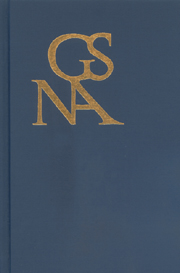Book contents
- Frontmatter
- Contents
- Illustrations
- Special section on childhood edited by Anthony Krupp
- Natural Palingenesis: Childhood, Memory, and Self-Experience in Herder and Jean Paul
- The Promises of Childhood: Autobiography in Goethe and Jean Paul
- The Education of Humankind: Perfectibility and Discipline in Kant's Lectures Über Pädagogik
- Kästchenwahl
- Sentimental Confusion: Art, Nature, and Aesthetic Autonomy in Goethe's Der Triumph der Empfindsamkeit
- Seeing the Light: Goethe's Märchen as Science—Newton's Science as Fairy Tale
- The Ironic “Tick” in Goethe's Egmont:The Potentials and Limits of the Modern Heroic and Poetic Ideal
- The Philosophical Concept of the Daemonic in Goethe's “Mächtiges Überraschen”
- “Die pilgernde Törin”: Genesis, Revaluation, and Mirroring in Goethe's Wanderjahre
- Book Reviews
“Die pilgernde Törin”: Genesis, Revaluation, and Mirroring in Goethe's Wanderjahre
from Special section on childhood edited by Anthony Krupp
Published online by Cambridge University Press: 05 February 2013
- Frontmatter
- Contents
- Illustrations
- Special section on childhood edited by Anthony Krupp
- Natural Palingenesis: Childhood, Memory, and Self-Experience in Herder and Jean Paul
- The Promises of Childhood: Autobiography in Goethe and Jean Paul
- The Education of Humankind: Perfectibility and Discipline in Kant's Lectures Über Pädagogik
- Kästchenwahl
- Sentimental Confusion: Art, Nature, and Aesthetic Autonomy in Goethe's Der Triumph der Empfindsamkeit
- Seeing the Light: Goethe's Märchen as Science—Newton's Science as Fairy Tale
- The Ironic “Tick” in Goethe's Egmont:The Potentials and Limits of the Modern Heroic and Poetic Ideal
- The Philosophical Concept of the Daemonic in Goethe's “Mächtiges Überraschen”
- “Die pilgernde Törin”: Genesis, Revaluation, and Mirroring in Goethe's Wanderjahre
- Book Reviews
Summary
The critical revaluation of the structure and content of Goethe's Wanderjahre in the past three decades has allowed most scholars to agree that the novel presents, not one narrative point of view, but many, indeed an “archive” of perspectives embodied in manuscripts and fragments from a wide cast of characters, assembled into the novel's present form by a fictional editor. Goethe is thereby credited with having anticipated the modern novel by his dispersal of the function of the author or narrator among a plethora of independently responsible narrators. Because no particular narrator is privileged as authoritative, the “implied reader” is obliged to participate actively in appropriating and understanding the text, almost as if it were fragments of reality to be processed. The primary structural principles by which Goethe organizes his materials and suggests ways for the reader to order and understand them are two: First,Wilhelm recedes as the center of attention and becomes a “string” on which to thread various stories and events that come to his attention. Second, the various materials “mirror” each other—not necessarily in sequence or pairs but as pieces whose themes or motifs reinforce, recall, illuminate, relativize, or call into doubt the perspectives expressed in other “mirroring” pieces through the novel.
- Type
- Chapter
- Information
- Goethe Yearbook 14 , pp. 171 - 206Publisher: Boydell & BrewerPrint publication year: 2007



